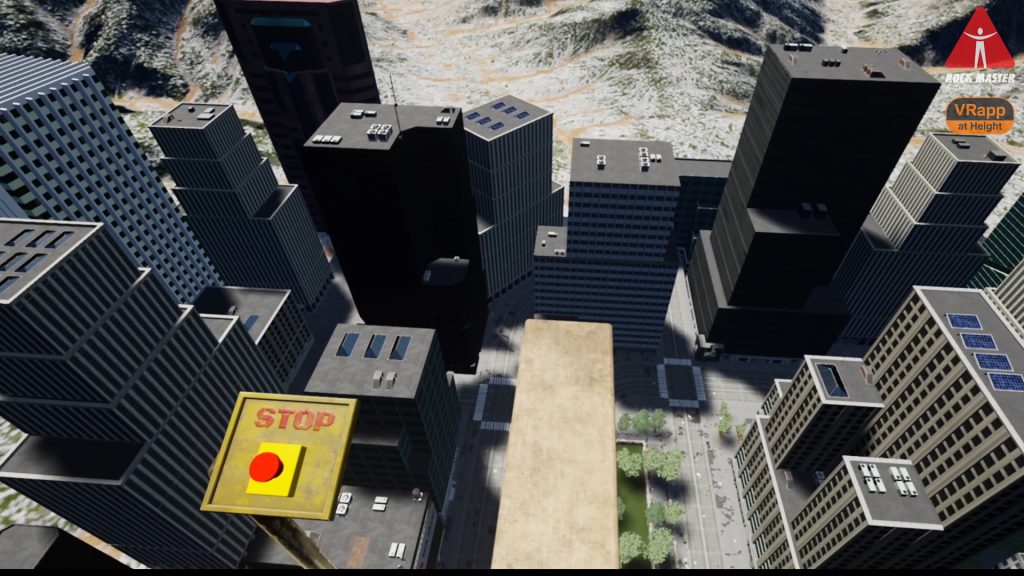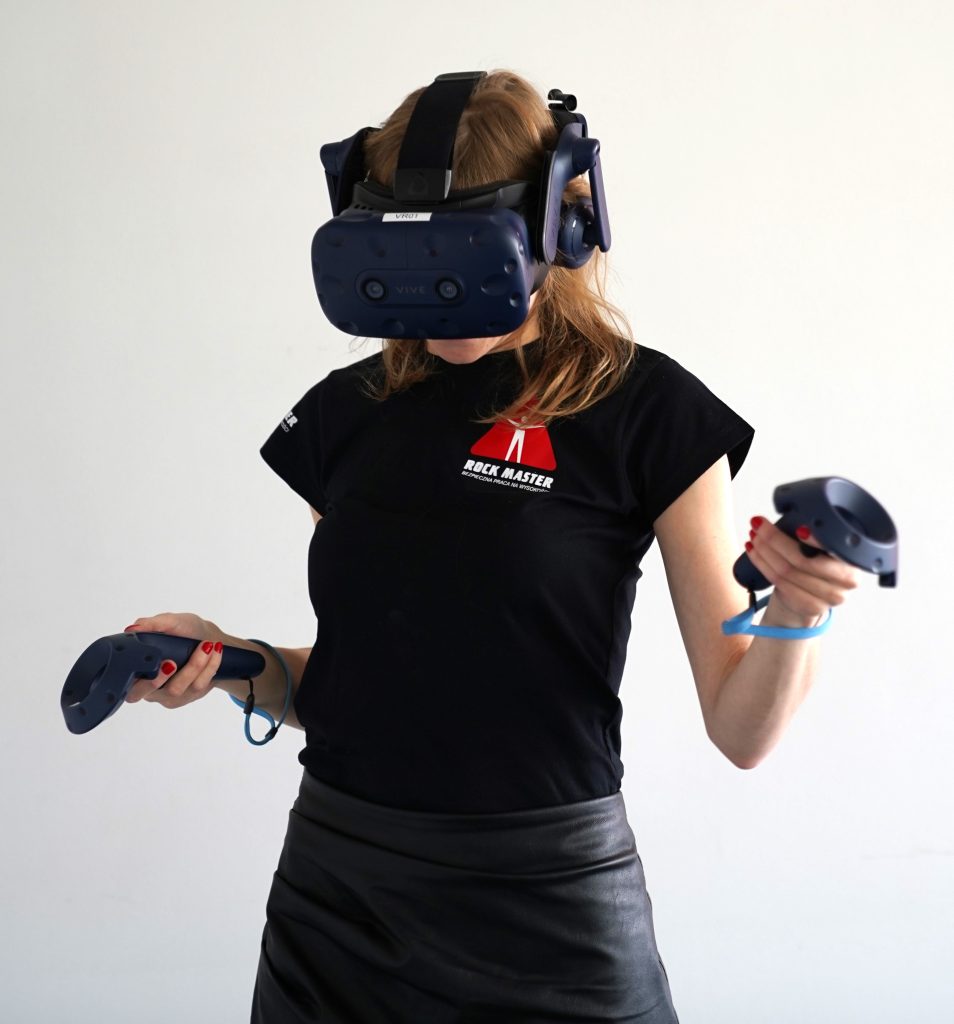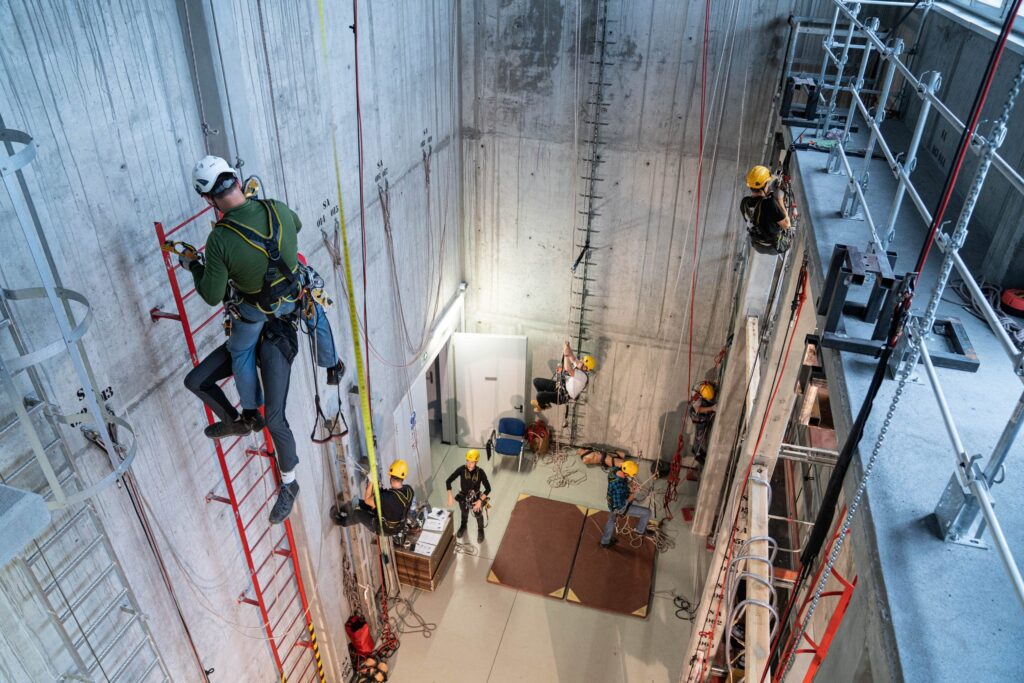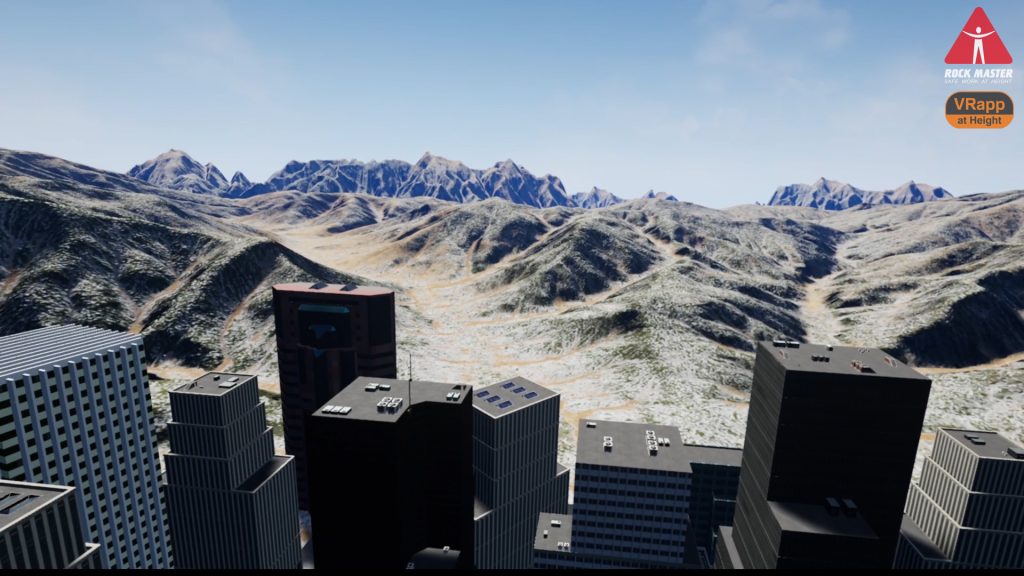Research and results
The effectiveness of VR technology in work at height training and acrophobia therapy
Reasons for conducting research in the context of work at height training
- Training operatives to work at height is an important aspect of safety and efficiency in various sectors
- Conventional training methods lack sufficient effectiveness, are costly and time-consuming
- The use of virtual reality in training is becoming more widespread

- Implementing VR technology can prove very beneficial, especially by providing hands-on experience without the need to build actual physical laboratories and without the usual security constraints (Polak, Tekla, 2019
- More than 50% of companies are already incorporating or planning to incorporate VR into their business strategy and a third sees in it an effective way to develop and train employees (PwC 2022 Report)
- The use of virtual reality (VR) technology in work at height training can provide a safe and controlled environment for skill acquisition. GSR with VR can extend training opportunities by monitoring and analysing participant responses in real time
- VR is an effective tool in safety training, outperforming conventional methods and more engaging for participants (Kanady, Duffy, 2022)
Research objective
Our aim was to investigate the effectiveness of using VR (virtual reality) technology in work at height training and behavioural therapy. Together with a group of psychologists, we tested seven hypotheses and attempted to assessmentine the influence of individual and socio-demographic characteristics of participants on the effectiveness of VR training.
HYPOTHESIS 1: Using VR technology in training is as effective as training at a training site (in real life)
HYPOTHESIS 2: Standard VR training game is more effective than a training site (in real life)
HYPOTHESIS 3: Shortening the training unit in favour of increasing the frequency (multi-shift method) makes training more effective
HYPOTHESIS 4: Training in a setting which replicates real working conditions (Learning Mode VR with applied environment) is more effective than training within a VR Standard mode
HYPOTHESIS 5: Training in a setting which replicates real working conditions (Learning Mode VR with applied environment) is more effective than training at a training site (real-life).
HYPOTHESIS 6: The use of virtual reality and simulated work at height in the desensitization process reduces fear of heights in people suffering from acrophobia

HYPOTHESIS 7: Introducing a sensitisation process to reduce risky behaviours and to develop automatic work behaviours in a virtual environment will improve the safety and efficiency of workers in a height exposure environment
An exploratory study comparing the effectiveness of virtual reality (VR) and conventional training in terms of individual differences and socio-demographic characteristics was also conducted
Reasons for research in the context of behavioural studies
- Studies using virtual reality to treat specific phobias such as acrophobia have shown promising results.
- VR technology, combined with mobile apps, has proven
to be an effective tool for exposure, comparable to in vivo exposure.

Research on the effectiveness of VR training
The study verified the first five research hypotheses. The first objective of the study was to evaluate the effectiveness of work at height training in different conditions: conventional (real-life) and using virtual reality (VR). Respondents from different industries and regions were randomly assigned to one of the two research conditions. In the VR training, respondents participated in a training video, a VR tutorial and games related to the training topic. There were three modes of VR training used: Basic, Learning and Multi-shift. Measurement tools included a socio-demographic questionnaire and a proprietary assessment unit to assess the trainees’ theoretical and practical knowledge.

The second objective of the study was to assess the psychological characteristics of persons taking part in work at height training and to compare the effectiveness of training using virtual reality (VR) and conventional methods. As part of the study, a series of pre- and post-training psychological tests were administered and a practical assessment was conducted.
Psychological testing: desensitisation
The study aimed to investigate the effectiveness of exposure therapy using virtual reality (VR) in reducing fear of heights (acrophobia). The study included three groups: a control group, an anxiety group and a group of WAH workers. The study used tools such as VR-based simulations dedicated to training for working at height, GSR devices to measure galvanic reactions, the STAI questionnaire to assess anxiety in two contexts (situational state and generalised trait), a questionnaire based on the Anxiety Symptom Inventory (SUDS) to determine the degree of anxiety symptoms while at height and an extract from the Simulator Sickness Questionnaire (SSQ) to assess

the level of simulator sickness. The study was conducted in two stages, with a sequence of tasks in VR, monitoring of participants with a GSR device and the option to stop participation in case of severe symptoms.
Procedure: Three study groups: high anxiety, low anxiety (WAH workers) and control group. Prior to the study, all participants completed the STAI questionnaire, assessing anxiety in a given situation as well as a general trait.
The study consisted of two stages, concluded within one week of one another. In the first stage, participants completed the SUDS questionnaire, were introduced to relaxation techniques and were given the task of self-training these techniques at home. This was followed by the actual study, in which participants were exposed to work-at-height situations in a VR simulation. After completing the tasks, the subjects again completed the SUDS questionnaire to assess their level of discomfort and the SSQ questionnaire to assess the severity of simulation-induced symptoms. The second phase of the study involved a follow-up assessment conducted one week after the initial session. Participants attended the VR session again and completed the SUDS and SSQ questionnaire to measure changes in their anxiety level when exposed to height and symptoms of simulator sickness.
Psychological testing: sensitisation
The study aimed to investigate the effectiveness of exposure therapy using virtual reality (VR) to reduce risky behaviours and to develop automatic work behaviours in work at height. VR simulations dedicated to training for working at heights and GSR devices to measure galvanic reactions were used. The State-Trait Anxiety Inventory (STAI) questionnaire was used to assess anxiety and a questionnaire based on the Anxiety Symptom Inventory and the Simulator Sickness Questionnaire to assess symptoms of anxiety and simulator sickness.

Procedure: The study sample was obtained from sten scores on the STAI questionnaire ranging from 1-4 on the anxiety scale as a trait.
The study procedure consisted of two stages conducted within three days of one another. Each participant was randomly assigned two of the 30 experimental scenarios. The actual study was conducted using VR technology and included a sequence of tasks to simulate situations and activities associated with working at height.
Participants carried the scenarios out in two modes: basic and stimulating. In the basic mode, errors made by the subjects during the task were recorded and counted. The first stage included only the basic mode, the second stage included both modes of the scenarios. During the simulation the subjects were monitored using a GSR (Galvanic Skin Response)
device.
Study findings
Hypothesis 1: VR training is equivalent in terms of effectiveness to training at a training site (real-life). Practical and theoretical assessment results did not differ between VR training and real-life training. Both training methods produced effective results, with participants achieving higher scores in the theoretical assessment after each of those training types. Conclusions: the results confirm the effectiveness of VR training compared to conventional training methods for work at height training.

Hypothesis 2: Training using the standard VR training game is more effective than training at a training site (real-life). The use of standard VR activities was not more effective than the real procedures on the training ground. The results of the practical and theoretical assessments showed no significant differences between the group using the VR training game and the group using conventional training at a training site. The lack of differences in effectiveness between the groups suggests that both training methods are equally effective in preparing participants for work at height.
Hypothesis 3: Shortening the length of a training unit in favour of increasing the frequency (multi-shift method) increases the effectiveness of training. During the multi-shift version of training the participants made the fewest errors. Shorter but more frequent training units contributed to better practical performance. The multi-shift method proved to be the most effective of the options analysed.
Hypothesis 4: Training in a setting that replicates real working conditions (so-called Learning VR with applied environment) is more effective than training in the Standard VR only. Trainees obtained high scores in the theory assessment, regardless of the type of training. Trainees using the Learning VR made fewer mistakes during the practical assessment as compared to trainees using the VR Standard version of training. Training in a setting that replicated real working conditions, ie. using the Learning VR method with applied environment, proved more effective in terms of practical results compared to training in Standard VR.
Hypothesis 5: Training in a setting that replicates real working conditions (so-called Learning VR with applied environment) is more effective than training at a training site (real-life) No differences were noticed between the groups in the theoretical knowledge assessment – both groups obtained a high average score. Trainees using VR Learning made fewer mistakes during the practical assessment than those trained at a training site. Training in a setting that replicates real working conditions (Learning VR with applied environment) proved more effective than training at a training site (real-life).
Hypothesis 6: The use of virtual reality and simulated work at height in the desensitization process reduces fear of heights in people suffering from acrophobia. Physiological data collected using the GSR devices confirmed a reduction in physiological response during VR tasks. The results of the SUDS and SSQ questionnaires showed a decrease in the level of perceived symptoms of anxiety and simulator sickness. The results indicate the effectiveness of VR simulation in behavioural therapy for fear of heights. The results of the study indicate potential for further research and possible implementation of VR in therapy. Virtual reality training can be an effective tool in reducing fear of heights for both acrophobia sufferers and employees working at heights. VR exposure therapy can have a positive impact on patients’/workers’ self-esteem, their agency and day-to-day functioning. A reduction in fear of heights can contribute to an improved quality of life and ability to perform work-related tasks at height.
Hypothesis 7: The use of virtual reality and simulated work at height in the desensitisation process reduces fear of heights in people suffering from acrophobia. The analysis of the SUDS and SSQ questionnaires showed no significant differences between the results obtained during the pre-test and post-test. The analysis of GSR parameters also showed no significant changes in reaction levels. The analysis of errors showed a significant reduction in the number of errors made on the third testing attempt as compared to the first. Also the time needed to complete a task time was significantly shorter on the second attempt as compared to the first.
Exploratory study: A comparison of the effectiveness of virtual reality (VR) and conventional training methods in terms of individual differences and socio-demographic characteristics of the participants. Individuals with higher levels of anxiety performed more poorly in both the theory and practical assessments in both the VR and conventional training. These results suggest that more anxious individuals may have difficulties focusing and performing effectively in complicated training situations. Place of residence had no significant effect on VR training outcomes, whereas, depending on place of residence, statistically significant differences in anxiety levels were observed in the conventional training group. It is important to consider psychological factors, such as anxiety levels, when planning and implementing both VR and conventional training. Individual differences and socio-demographic characteristics of participants can affect the effectiveness of training as well.




